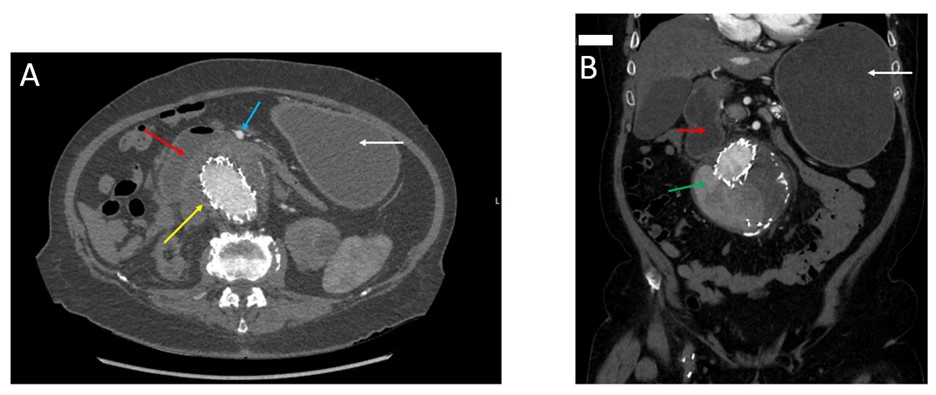Tuesday Poster Session
Category: Small Intestine
P4968 - A Rare Case of Duodenal Obstruction Due to Endovascular Aneurysm Endoleak
Tuesday, October 29, 2024
10:30 AM - 4:00 PM ET
Location: Exhibit Hall E

Has Audio

Raksha Adhikari, DO, MSPH
Morristown Medical Center
Morristown, NJ
Presenting Author(s)
Raksha Adhikari, DO, MSPH, Parth Patel, BS, Christopher Tait, MD
Morristown Medical Center, Morristown, NJ
Introduction: Aortoduodenal syndrome (ADS) is a rare duodenal obstructive condition that occurs due to abdominal aortic aneurysm (AAA) expansion causing extrinsic compression of the duodenum, leading to obstructive upper gastrointestinal (GI) symptoms. Endovascular aneurysm repair (EVAR) of large or symptomatic AAA is an important treatment modality though these grafts are complicated by endoleaks. We present a case of rapidly worsening obstructive GI symptoms in a patient with an already repaired aortic stent graft, found to be due to type III endoleak that improved after emergent repeat EVAR.
Case Description/Methods: A 76-year-old male with AAA status post previous EVAR and chronic kidney disease stage 3 with solitary left kidney presented with worsening constipation and urinary retention. Laboratory showed a creatinine of 5.5 mg/dL (baseline 1.6 mg/dL). Over a week, he developed worsening nausea with recurrent vomiting and poor oral intake. A CT angiography of the abdomen and pelvis confirmed enlarging infrarenal AAA, which increased in size to 12 cm from 8 cm on a scan done two weeks prior, along with type III endoleak causing duodenal and gastric outlet obstruction secondary to extrinsic compression of the 3rd portion of the duodenum (Figure 1A, 1B). The patient was taken for emergent EVAR with vascular surgery and was admitted to the surgical intensive care unit post-operation. He had a nasogastric (NG) tube in place that was on suction and had high suction volume per NG tube initially after repair. A post-operative upper GI series showed contrast traversing the duodenum with no obstruction. He was trialed on liquids and eventually diet was advanced. Patient was started on dialysis and discharged home after permacath placement.
Discussion: Our case is unique in that the patient had already undergone EVAR and had ADS after a rapidly enlarging type III endoleak 13 years after AAA repair. Due to the rise of EVAR, it is important for gastroenterologists to recognize aortic endoleak as a potential source of GI obstruction, especially in cases with chronic indwelling grafts. Gastroenterologists must also be aware of an indolent presentation after endoleak, where acute obstructive GI symptoms or a pulsatile mass on physical exam may not be present. Our patient’s obstructive GI symptoms persisted initially after EVAR for almost a week, prompting discussion about the potential need for distal enteral feeding access or gastrojejunostomy. Fortunately, his symptoms improved, and no further intervention was needed.

Disclosures:
Raksha Adhikari, DO, MSPH, Parth Patel, BS, Christopher Tait, MD. P4968 - A Rare Case of Duodenal Obstruction Due to Endovascular Aneurysm Endoleak, ACG 2024 Annual Scientific Meeting Abstracts. Philadelphia, PA: American College of Gastroenterology.
Morristown Medical Center, Morristown, NJ
Introduction: Aortoduodenal syndrome (ADS) is a rare duodenal obstructive condition that occurs due to abdominal aortic aneurysm (AAA) expansion causing extrinsic compression of the duodenum, leading to obstructive upper gastrointestinal (GI) symptoms. Endovascular aneurysm repair (EVAR) of large or symptomatic AAA is an important treatment modality though these grafts are complicated by endoleaks. We present a case of rapidly worsening obstructive GI symptoms in a patient with an already repaired aortic stent graft, found to be due to type III endoleak that improved after emergent repeat EVAR.
Case Description/Methods: A 76-year-old male with AAA status post previous EVAR and chronic kidney disease stage 3 with solitary left kidney presented with worsening constipation and urinary retention. Laboratory showed a creatinine of 5.5 mg/dL (baseline 1.6 mg/dL). Over a week, he developed worsening nausea with recurrent vomiting and poor oral intake. A CT angiography of the abdomen and pelvis confirmed enlarging infrarenal AAA, which increased in size to 12 cm from 8 cm on a scan done two weeks prior, along with type III endoleak causing duodenal and gastric outlet obstruction secondary to extrinsic compression of the 3rd portion of the duodenum (Figure 1A, 1B). The patient was taken for emergent EVAR with vascular surgery and was admitted to the surgical intensive care unit post-operation. He had a nasogastric (NG) tube in place that was on suction and had high suction volume per NG tube initially after repair. A post-operative upper GI series showed contrast traversing the duodenum with no obstruction. He was trialed on liquids and eventually diet was advanced. Patient was started on dialysis and discharged home after permacath placement.
Discussion: Our case is unique in that the patient had already undergone EVAR and had ADS after a rapidly enlarging type III endoleak 13 years after AAA repair. Due to the rise of EVAR, it is important for gastroenterologists to recognize aortic endoleak as a potential source of GI obstruction, especially in cases with chronic indwelling grafts. Gastroenterologists must also be aware of an indolent presentation after endoleak, where acute obstructive GI symptoms or a pulsatile mass on physical exam may not be present. Our patient’s obstructive GI symptoms persisted initially after EVAR for almost a week, prompting discussion about the potential need for distal enteral feeding access or gastrojejunostomy. Fortunately, his symptoms improved, and no further intervention was needed.

Figure: Figure 1: A) Axial view of a CT angiogram of the abdomen and pelvis showing the AAA with previous endograft in place (yellow) externally compressing the 3rd portion of the duodenum. There is severe distention of the stomach (white arrow) up to the 3rd portion of the duodenum (red arrow). Blue arrow shows the superior mesenteric artery. B) Coronal view of a CT angiogram of the abdomen and pelvis showing the aforementioned findings along with endoleak (green arrow).
Disclosures:
Raksha Adhikari indicated no relevant financial relationships.
Parth Patel indicated no relevant financial relationships.
Christopher Tait indicated no relevant financial relationships.
Raksha Adhikari, DO, MSPH, Parth Patel, BS, Christopher Tait, MD. P4968 - A Rare Case of Duodenal Obstruction Due to Endovascular Aneurysm Endoleak, ACG 2024 Annual Scientific Meeting Abstracts. Philadelphia, PA: American College of Gastroenterology.
